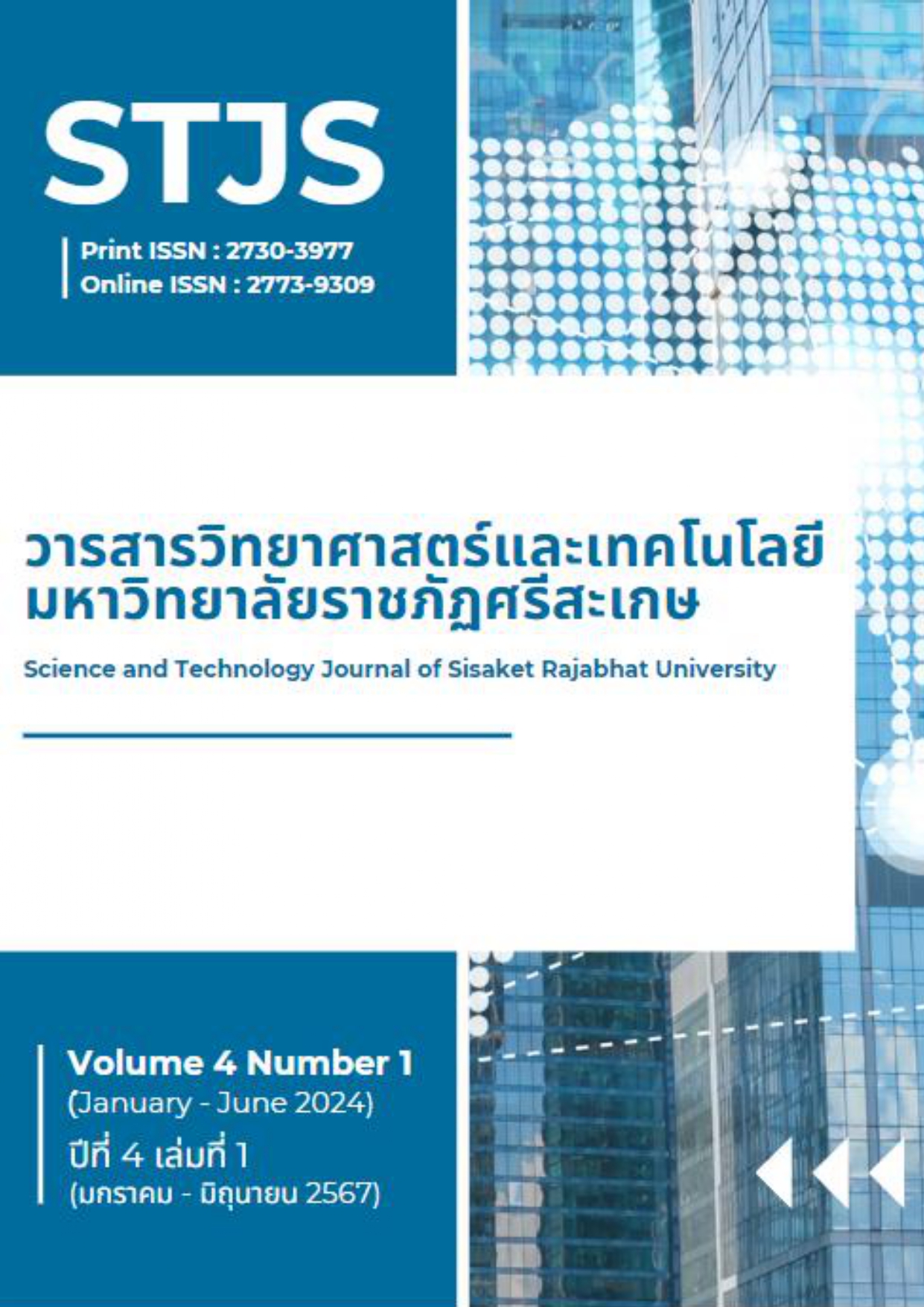การบำบัดน้ำเสียจากศูนย์อาหารโรงเรียนไกรภักดีวิทยาคมด้วยจุลินทรีย์ประสิทธิภาพอัดแท่ง
Main Article Content
บทคัดย่อ
ผสมเปลือกสับปะรดแบบอบ คิดเป็นร้อยละ 99.63 สูตรที่ช่วยเพิ่มปริมาณ DO ได้ดีคือ EM อัดแท่งสูตรผสมผักตบชวา ทั้ง 3 แบบ จาก 15.53 mg/L เพิ่มขึ้นเป็น 28.73 mg/L สูตรกำจัด BOD ได้ดี คือ EM อัดแท่ง
สูตรผสมเปลือกสับปะรดแบบอบ และแบบตากลม คิดเป็นร้อยละ 100 สูตรที่ลด TDS ได้ดีที่สุด คือ EM อัดแท่ง
สูตรผสมผักตบชวาแบบตากลม คิดเป็นร้อยละ 84.74 สูตรที่ปรับปรุง pH ได้ดี คือ EM อัดแท่งทั้ง2 สูตร และสามารถใช้ได้ทุกแบบ ซึ่งมีค่าอยู่ในช่วงของเกณฑ์มาตรฐานน้ำผิวดินกำหนดหากจะมีการเลือก EM
อัดแท่ง ไปใช้ในการบำบัดน้ำเสีย ควรเลือกใช้สูตรผสมเปลือกสับปะรด เพราะมีประสิทธิภาพในการบำบัดพารามิเตอร์ต่าง ๆ ได้ดีกว่าสูตรผสมผักตบชวา
Article Details

อนุญาตภายใต้เงื่อนไข Creative Commons Attribution-NonCommercial-NoDerivatives 4.0 International License.
เนื้อหาและข้อมูลในบทความที่ลงตีพิมพ์ในวารสารวิทยาศาสตร์และเทคโนโลยี มหาวิทยาลัยราชภัฏศรีสะเกษ ถือเป็นข้อคิดเห็นและความรับผิดชอบของผู้เขียนบทความโดยตรงซึ่งกองบรรณาธิการวารสาร ไม่จำเป็นต้องเห็นด้วย หรือร่วมรับผิดชอบใด ๆ
บทความ ข้อมูล เนื้อหา รูปภาพ ฯลฯ ที่ได้รับการตีพิมพ์ในวารสารวิทยาศาสตร์และเทคโนโลยี มหาวิทยาลัยราชภัฏศรีสะเกษ ถือเป็นลิขสิทธิ์ของวิทยาศาสตร์และเทคโนโลยี มหาวิทยาลัยราชภัฏศรีสะเกษ หากบุคคลหรือหน่วยงานใดต้องการนำทั้งหมดหรือส่วนหนึ่งส่วนใดไปเผยแพร่ต่อหรือเพื่อกระทำการใด จะต้องได้รับอนุญาตเป็นลายลักอักษรจากวารสารวิทยาศาสตร์และเทคโนโลยี มหาวิทยาลัยราชภัฏศรีสะเกษ ก่อนเท่านั้น
เอกสารอ้างอิง
American Public Health Association. (2017). Standard Methods for the Examination of Water and Wastewater, 23rd ed. Washington: American Public Health Association.
Ehrlich, HL. (2002). Geomicrobiology, 4th ed. New York: Marcel Dekker.
Firdaus, A., & Azman, S. (2018). Improvement of Sungai Sebulung Water Quality Using Effective Microorganism. International Journal of Engineering & Technology, 7(3.9), 59-61.
Itsaranuwat, P. (2005). Effective microorganisms for agricultural nature. Khon Kaen Agriculture Journal, 33, 175-183. (in Thai).
Kunsuwan, D. (2012). Environmental Influences: Suitable environment for microorganisms [Online]. Retrieved January 15, 2012, from: http://www.sites.google.com/site/deunpen601/4-xiththiphl-khxng-sphaph-waedlxm. (in Thai)
Namsivayam, SKR, Narendrakumar, G., & Kumar, JA. (2011). Evaluation of Effective Microorganism (EM) for treatment of domestic sewage. Journal of Experimental Sciences, 2(7), 30-32.
Office of Natural Resources and Environmental Policy and Planning. (2019). Situation report Environmental quality 2019. Research report. Bangkok: Office of Policy and Planning Natural resources and environment. (in Thai)
Okuda, A., & Higa, T. (2009). Purification of wastewater with effective microorganisms and its utilization in agriculture [Online]. Retrieved October 18, 2009, from: http://emfsafe.com/em/EMWWT&AG Japan.pdf
Park, GS., Khan, AR., Kwak, Y., et al. (2016). An improved effective microorganism (EM) soil ball-making method for water quality restoration. Environmental Science and Pollution Research, 23(2), 1100-1107.
Pimpuang, T. (2016). Study of the use of effective microbial briquettes for wastewater treatment. Health education program. Pattani: Department of Physical Education, Faculty of Education, Prince of Songkla University, Pattani Campus. (in Thai)
Pollution Control Department. (2017). Manual for domestic wastewater and wastewater treatment systems [Online]. Retrieved July 20, 2023, from: http://www.oic.g o.th/FILEWER CABINFOCENTER3/DRAWE R056/ GENERAL/ DATA0000/00000973.PDF. (in Thai)
Riyakan, I. (2012). Wastewater Treatment by Effective Microorganism Ball: A Case Study of Wastewater Sample from San-Sab Canal. Master of Science Thesis. Bangkok: National Institute of Development Administration. (in Thai)
Siriananpaiboon, S. (2006). Wastewater treatment system, selection, design, operation and solutions. Bangkok: Chulalongkorn University. (in Thai)
Sirirote, P., Sawanon, S., & Wangkubkiat, A. (1995). Swine manure wastewater treatment and biogas production by using EM. Paper presented at the conference of EM research project and the effects on agriculture and environment. Thailand: Bangkok. (in Thai)
Sirising, K. (1982). Chemical analysis of water and sewage. Bangkok: Faculty of Health Sciences, Mahidol University. (in Thai)
Wahid, W., & Azman, S. (2016). Improvement of Water Quality using Effective Microorganisms. Proceeding of the 1st Environmental Engineering, Hydraulics and Hydrology, June 7-8, 2016. Malaysia: University Technology Malasia, 57-66.
Zakaria, Z., Gairola, S., & Sharif, NM. (2010). Effective Microorganisms (EM) Technology for Water Quality Restoration and Potential for Sustainable Water Resources and Management. Proceedings of 5th International Congress on Environmental Modelling and Software, July 1, 2010. Canada: Ontario. 448-456.


